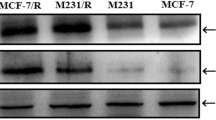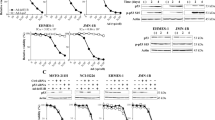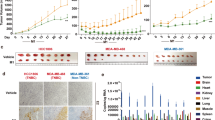Abstract
Melanoma differentiation associated gene-7 (Mda-7)/IL-24 was previously cloned into ZD55 (an adenovirus with E1B55 deleted) to form ZD55-IL-24, which had much better antitumor effect than Ad-IL-24. According to its good antitumor properties, ZD55-IL-24 has been used in preclinical studies. But ZD55-IL-24 alone still could not completely eradicate established tumors in all nude mice. It was reported that IL-24 could induce and enhance the activity of tumor necrosis factor-related apoptosis-inducing ligand (TRAIL) (a member of tumor necrosis factor (TNF) superfamily). Accordingly, the combined use of ZD55-IL-24 and ZD55-TRAIL was carried out in this study. Treatment with both ZD55-IL-24 and ZD55-TRAIL could induce more significant apoptosis in cancer cells in vitro compared with ZD55-IL-24 or ZD55-TRAIL alone. The combination of the two replicative adenoviruses had better antitumor activity in vivo than that of single oncolytic adenovirus and led to complete eradication of xenograft tumors in all treated mice. Upregulation of TRAIL was observed in tumor cells infected with ZD55-IL-24 and studies of the apoptotic cascade regulators indicate that ZD55-IL-24 could further enhance the activation of apoptosis through the TNF family of death receptors. We demonstrated for the first time the potential therapeutic effect of combined ZD55-IL-24 with ZD55-TRAIL for the targeted therapy of cancer.
This is a preview of subscription content, access via your institution
Access options
Subscribe to this journal
Receive 12 print issues and online access
$259.00 per year
only $21.58 per issue
Buy this article
- Purchase on Springer Link
- Instant access to full article PDF
Prices may be subject to local taxes which are calculated during checkout






Similar content being viewed by others
Abbreviations
- CPE:
-
cytopathic effect
- DR4:
-
death receptor 4
- Mda-7:
-
melanoma differentiation associated gene-7
- MOI:
-
multiplicity of infection
- MTT:
-
3-(4,5-dimethylthiazol-2-yl)-2,5-diphenyltetrazolium bromide
- PARP:
-
poly(ADP-ribose) polymerase
- TUNEL:
-
TdT-mediated dUTP-biotin nick end labeling
- ZD55:
-
recombinant adenovirus with E1B 55 KDa gene deletion
References
Jiang H, Lin JJ, Su ZZ, Goldstein NI, Fisher PB . Subtraction hybridization identifies a novel melanoma differentiation associated gene, mda-7, modulated during human melanoma differentiation, growth and progression. Oncogene 1995; 11: 2477–2486.
Lebedeva IV, Su ZZ, Chang Y, Kitada S, Reed JC, Fisher PB . The cancer growth suppressing gene mda-7 induces apoptosis selectively in human melanoma cells. Oncogene 2002; 21: 708–718.
Lebedeva IV, Sarkar D, Su ZZ, Kitada S, Dent P, Stein CA et al. Bcl-2 and Bcl-xL differentially protect human prostate cancer cells from induction of apoptosis by melanoma differentiation associated gene-7, mda-7/IL-24. Oncogene 2003; 22: 8758–8773.
Su ZZ, Madireddi MT, Lin JJ, Young CS, Kitada S, Reed JC et al. The cancer growth suppressor gene mda-7 selectively induces apoptosis in human breast cancer cells and inhibits tumor growth in nude mice. Proc Natl Acad Sci USA 1998; 95: 14400–14405.
Saeki T, Mhashilkar A, Chada S, Branch C, Roth JA, Ramesh R . Tumor-suppressive effects by adenovirus-mediated mda-7 gene transfer in non-small cell lung cancer cell in vitro. Gene Therapy 2000; 7: 2051–2057.
Cao XX, Mohuiddin I, Chada S, Mhashilkar AM, Ozvaran MK, McConkey DJ et al. Adenoviral transfer of mda-7 leads to BAX up-regulation and apoptosis in mesothelioma cells, and is abrogated by over-expression of BCL-XL. Mol Med 2002; 8: 869–876.
Sarkar D, Su ZZ, Lebedeva IV, Sauane M, Gopalkrishnan RV, Valerie K et al. Mda-7 (IL-24) mediates selective apoptosis in human melanoma cells by inducing the coordinated overexpression of the GADD family of genes by means of p38 MAPK. Proc Natl Acad Sci USA 2002; 99: 10054–10059.
Saeki T, Mhashilkar A, Swanson X, Zou-Yang XH, Sieger K, Kawabe S et al. Inhibition of human lung cancer growth following adenovirus-mediated mda-7 gene expression in vivo. Oncogene 2002; 21: 4558–4566.
Pataer A, Vorburger SA, Barber GN, Chada S, Mhashilkar AM, Zou-Yang H et al. Adenoviral transfer of the melanoma differentiation-associated gene-7 (mda-7) induces apoptosis of lung cancer cells via up-regulation of the double-stranded RNA-dependent protein kinase (PKR). Cancer Res 2002; 62: 2239–2243.
Pataer A, Vorburger SA, Chada S, Balachandran S, Barber GN, Roth JA et al. Melanoma differentiation-associated gene-7 protein physically associates with the double-stranded RNA-activated protein kinase PKR. Mol Ther 2005; 11: 717–723.
Ekmekcioglu S, Ellerhorst JA, Mumm JB, Zheng M, Broemeling L, Prieto VG et al. Negative association of melanoma differentiation associated gene (mda-7) and inducible nitric oxide synthase (iNOS) in human melanoma: MDA-7 regulates iNOS expression in melanoma cells. Mol Cancer Ther 2003; 2: 9–17.
Mhashilkar AM, Stewart AL, Sieger K, Yang HY, Khimani AH, Ito I et al. MDA-7 negatively regulates the beta-catenin and PI3K signaling pathways in breast and lung tumor cells. Mol Ther 2003; 8: 207–219.
Sauane M, Gopalkrishnan RV, Lebedeva I, Mei MX, Sarkar D, Su ZZ et al. Mda-7/IL-24 induces apoptosis of diverse cancer cell lines through JAK/STAT-independent pathways. J Cell Physiol 2003; 196: 334–345.
Ishikawa S, Nakagawa T, Miyahara R, Kawano Y, Takenaka K, Yanagihara K et al. Expression of MDA-7/IL-24 and its clinical significance in resected non-small cell lung cancer. Clin Cancer Res 2005; 11: 1198–1202.
Tong AW, Nemunaitis J, Su D, Zhang Y, Cunningham C, Senzer N et al. Intratumoral injection of INGN241, a nonreplicating adenovector expressing the melanoma-differentiation associated gene-7 (mda-7/IL-24): biologic outcome in advanced cancer patients. Mol Ther 2005; 11: 161–172.
Cunningham CC, Chada S, Merritt JA, Tong A, Senzer N, Zhang Y et al. Clinical and local biological effects of an intratumoral injection of mda-7 (IL-24; INGN241) in patients with advanced carcinoma: a phase I study. Mol Ther 2005; 11: 149–159.
Lebedeva IV, Sauane M, Gopalkrishnan RV, Sarkar D, Su ZZ, Gupta P et al. Mda-7/IL-24: exploring cancer's achille's heel. Mol Ther 2005; 11: 4–18.
Zhang ZL, Zou WG, Luo CX, Li BH, Wang JH, Sun LY et al. An armed oncolytic adenovirus system ZD55-gene, demonstrating potent antitumoral efficacy. Cell Res 2003; 13: 481–489.
Zhang Z, Zou W, Wang J, Gu J, Dang Y, Li B et al. Suppression of tumor growth by oncolytic adenovirus-mediated delivery of an antiangiogenic gene, sflt-1(1-3). Mol Ther 2005; 11: 553–562.
Zhao L, Gu J, Dong A, Zhang Y, Zhong L, He L et al. Potent antitumor activity of oncolytic adenovirus expressing mda-7/IL-24 for colorectal cancer. Hum Gene Ther 2005; 16: 845–858.
Wiley SR, Schooley K, Smolak PJ, Din WS, Huang CP, Nicholl JK et al. Identification and characterization of a new member of the TNF family that induces apoptosis. Immunity 1995; 3: 673–682.
Kagawa S, He C, Gu J, Koch P, Rha SJ, Roth JA et al. Antitumor activity and bystander effects of the tumor necrosis factor-related apoptosis-inducing ligand (TRAIL) gene. Cancer Res 2001; 61: 3330–3338.
Shi J, Zheng D, Liu Y, Sham MH, Tam P, Farzaneh F et al. Overexpression of soluble TRAIL induces apoptosis in human lung adenocarcinoma and inhibits growth of tumor xenografts in nude mice. Cancer Res 2005; 65: 1687–1692.
Griffith TS, Anderson RD, Davidson BL, Williams RD, Ratliff TL . Adenoviral-mediated transfer of the TNF-related apoptosis-inducing ligand/Apo-2 ligand gene induces tumor cell apoptosis. J Immunol 2000; 165: 2886–2894.
Lee J, Hampl M, Albert P, Fine HA . Antitumor activity and prolonged expression from a TRAIL-expressing adenoviral vector. Neoplasia 2002; 4: 312–323.
Griffith TS, Broghammer EL . Suppression of tumor growth following intralesional therapy with TRAIL recombinant adenovirus. Mol Ther 2001; 4: 257–266.
Sova P, Ren XW, Ni S, Bernt KM, Mi J, Kiviat N et al. A tumor-targeted and conditionally replicating oncolytic adenovirus vector expressing TRAIL for treatment of liver metastases. Mol Ther 2004; 9: 496–509.
Lin T, Zhang L, Davis J, Gu J, Nishizaki M, Ji L et al. Combination of TRAIL gene therapy and chemotherapy enhances antitumor and antimetastasis effects in chemosensitive and chemoresistant breast cancers. Mol Ther 2003; 8: 441–448.
Nishizaki M, Sasaki J, Fang B, Atkinson EN, Minna JD, Roth JA et al. Synergistic tumor suppression by coexpression of FHIT and p53 coincides with FHIT-mediated MDM2 inactivation and p53 stabilization in human non-small cell lung cancer cells. Cancer Res 2004; 64: 5745–5752.
Huang X, Lin T, Gu J, Zhang L, Roth JA, Stephens LC et al. Combined TRAIL and bax gene therapy prolonged survival in mice with ovarian cancer xenograft. Gene Therapy 2002; 9: 1379–1386.
Mhashilkar AM, Schrock RD, Hindi M, Liao J, Sieger K, Kourouma F et al. Melanoma differentiation associated gene-7 (mda-7): a novel anti-tumor gene for cancer gene therapy. Mol Med 2001; 7: 271–282.
Chada S, Sutton RB, Ekmekcioglu S, Ellerhorst J, Mumm JB, Leitner WW et al. MDA-7/IL-24 is a unique cytokine–tumor suppressor in the IL-10 family. Int Immunopharmacol 2004; 4: 649–667.
Fisher PB, Gopalkrishnan RV, Chada S, Ramesh R, Grimm EA, Rosenfeld MR et al. Mda-7/IL-24, a novel cancer selective apoptosis inducing cytokine gene. Cancer Bio Ther 2003; 2: 24–38.
Ramesh R, Ito I, Gopalan B, Saito Y, Mhashilkar AM, Chada S . Ectopic production of MDA-7/IL-24 inhibits invasion and migration of human lung cancer cells. Mol Ther 2004; 9: 510–518.
Chen J, Chada S, Mhashilkar A, Miano JM . Tumor suppressor MDA-7/IL-24 selectively inhibits vascular smooth muscle cell growth and migration. Mol Ther 2003; 8: 220–229.
Nishikawa T, Ramesh R, Munshi A, Chada S, Meyn RE . Adenovirus-mediated mda-7 (IL-24) gene therapy suppresses angiogenesis and sensitizes NSCLC xenograft tumors to radiation. Mol Ther 2004; 9: 818–928.
Ramesh R, Mhashilkar AM, Tanaka F, Saito Y, Branch CD, Sieger K et al. Melanoma differentiation-associated gene 7/interleukin (IL-24) is a novel ligand that regulates angiogenesis via the IL-22 receptor. Cancer Res 2003; 63: 5105–5113.
Caudell EG, Mumm JB, Poindexter N, Ekmekcioglu S, Mhashilkar AM, Yang XH et al. The protein product of the tumor suppressor gene, melanoma differentiation-associated gene 7, exhibits immunostimulatory activity and is designated IL-24. J Immunol 2002; 168: 6041–6046.
Chada S, Sutton RB, Ekmekcioglu S, Ellerhorst J, Mumm JB, Leitner WW et al. MDA-7/IL-24 is a unique cytokine--tumor suppressor in the IL-10 family. Int Immunopharmacol 2004; 4: 649–667.
Chada S, Mhashilkar AM, Ramesh R, Mumm JB, Sutton RB, Bocangel D et al. Bystander activity of Ad-mda7: human MDA-7 protein kills melanoma cells via an IL-20 receptor-dependent but STAT3-independent mechanism. Mol Ther 2004; 10: 1085–1095.
Addison CL, Bramson JL, Hitt MM, Muller WJ, Gauldie J, Graham FL . Intratumoral coinjection of adenoviral vectors expressing IL-2 and IL-12 results in enhanced frequency of regression of injected and untreated distal tumors. Gene Therapy 1998; 5: 1400–1409.
Nasu Y, Bangma CH, Hull GW, Yang G, Wang J, Shimura S et al. Combination gene therapy with adenoviral vector-mediated HSV-tk+GCV and IL-12 in an orthotopic mouse model for prostate cancer. Prostate Cancer Prostatic Dis 2001; 4: 44–55.
Caruso M, Pham-Nguyen K, Kwong YL, Xu B, Kosai KI, Finegold M et al. Adenovirus-mediated interleukin-12 gene therapy for metastatic colon carcinoma. Proc Natl Acad Sci USA 1996; 93: 11302–11306.
Drozdzik M, Qian C, Xie X, Peng D, Bilbao R, Mazzolini G et al. Combined gene therapy with suicide gene and interleukin-12 is more efficient than therapy with one gene alone in a murine model of hepatocellular carcinoma. J Hepatol 2000; 32: 279–286.
Wilczynska U, Kucharska A, Szary J, Szala S . Combined delivery of an antiangiogenic protein (angiostatin) and an immunomodulatory gene (interleukin-12) in the treatment of murine cancer. Acta Biochim Pol 2001; 48: 1077–1084.
Kagawa S, He C, Gu J, Koch P, Rha SJ, Roth JA et al. Antitumor activity and bystander effects of the tumor necrosis factor-related apoptosis-inducing ligand (TRAIL) gene. Cancer Res 2001; 61: 3330–3338.
Griffith TS, Anderson RD, Davidson BL, Williams RD, Ratliff TL . Adenoviral-mediated transfer of the TNF-related apoptosis-inducing ligand/Apo-2 ligand gene induces tumor cell apoptosis. J Immunol 2000; 165: 2886–2894.
Acknowledgements
This work was supported by grants from the National Natural Science Foundation of China (No. 30120160823), the Chinese National 863 High Technology R&D Project of China (No. 2003AA216031 and No. 2002AA216021) and the 973 Project (No. 2004CB518804), UTE project of CIMA and grant Instituto Carlos III C03/02 (Spain). We also thank Lanyin Sun and Jinfa Gu for help in professional technical assistance.
Author information
Authors and Affiliations
Corresponding author
Rights and permissions
About this article
Cite this article
Zhao, L., Dong, A., Gu, J. et al. The antitumor activity of TRAIL and IL-24 with replicating oncolytic adenovirus in colorectal cancer. Cancer Gene Ther 13, 1011–1022 (2006). https://doi.org/10.1038/sj.cgt.7700969
Received:
Revised:
Accepted:
Published:
Issue Date:
DOI: https://doi.org/10.1038/sj.cgt.7700969
Keywords
This article is cited by
-
The armed oncolytic adenovirus ZD55-IL-24 eradicates melanoma by turning the tumor cells from the self-state into the nonself-state besides direct killing
Cell Death & Disease (2020)
-
Enhanced antitumor effect of combining TRAIL and MnSOD mediated by CEA-controlled oncolytic adenovirus in lung cancer
Cancer Gene Therapy (2016)
-
RGD-modifided oncolytic adenovirus exhibited potent cytotoxic effect on CAR-negative bladder cancer-initiating cells
Cell Death & Disease (2015)
-
Enhanced antitumor efficacy of a novel oncolytic adenovirus combined with temozolomide in the treatment of melanoma in vivo
Journal of Cancer Research and Clinical Oncology (2015)
-
Combining virotherapy and angiotherapy for the treatment of breast cancer
Cancer Gene Therapy (2013)



